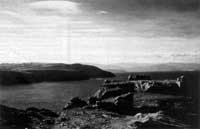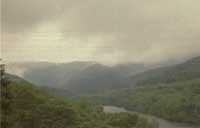Aliseda in search of fruits
1988/02/01 Arizmendiarrieta, J. Iturria: Elhuyar aldizkaria

The term derived to the alder necessarily leads us to the alder. Thus, the Basque people expressed the most traditional and popular use of alder wood. However, this undervalued tree has other less known ecological applications.
Alnus glutinosa (Linn. ), It is an average tree 20-22 meters high. This tree, which in special conditions can reach a height of 35 meters, is easily recognizable, since it is the only planfolio with cones (similar to those of conifers) visible throughout the year. Its average period of life barely exceeds the century.
The right trunk develops very wide secondary branches. When the skin is young, it is soft and brown-green, but over the years it darkens (dark gray to almost black) forming longitudinal cracks. The dome, with its compact leaves, is at first pyramidal and regular by its main monosodium abortion.
Then, when the tree ages, the scale is rounded by embracing irregularly.
The deciduous, alternate leaves appearing in April-May are 4-10 cm long. 5-8 pairs of nerves with circular limbo and short petiole. The upper surface is smooth (toothed edge) and the width is around the apex. The green-dark summer color of the leaves darkens in autumn reaching almost black. The leaves, when young, are glutinous, that is, adhesive.
In February-March it launches monoecious flowers grouped in floral associations of decorative type. Therefore, before the leaves, the hanging, brown, long and cylindrical males extend, releasing the yellow pollen. In this case, we can see the females (red, slow red, short pendulums and rough scales) that remain upright in some way. After pollination, in autumn, the fruits that mature and lignify become round green cones, which resemble the small pine. The seeds are dispersed in autumn, although the pinocchio remains in the tree another year. Each seed is a simple brain with two floating ones that give it the ability to float in the water.
The strongly embraced root system is superficial and compact, especially in shallow humid soils. It does not have a special central root, even when it is young. The secondary roots are inclined or almost horizontal, from which tertiary vertical roots of fixation are formed.

Its roots are formed by brain nodules of a few centimeters in diameter. The transept that inhabits these nodules can fix atmospheric nitrogen. Nitrogen fixation involves reducing atmospheric nitrogen to ammonia under normal pressure conditions. This process facilitates the growth of the plant without any nitrogen fertilizer, since it incorporates ammonia in its photosynthesis products making it protein. Aborigines or nitrogen surpluses enrich the soil. Therefore, plants that cannot take nitrogen from the air can take advantage of this abortion to complete their growth process.
The suction of wood strips has important ecological consequences: The riparian bushes are rejuvenated, since just as the old tree reproduces well with seed and is also easily rotated from the slag.
In addition, pruning can help the fixing process, as young nitrogen fixation nodules are more effective than old nodules, and in turn, the age of the nodule is related to the age of the root in which it is found.
Thus, since the fixation rates are very variable, the following fixing conditions should be taken into account:
- Plant age and consistency Size
- Environmental conditions
and number of nodules
Therefore, a maximum and minimum fixation rate of 325 to 56 Nkg/ha has been estimated.
The alder is a species of rapid growth, with wax and resistant to large temperature variations. It requires loose pavements with permanent humidity, that is, it is located in floors with a very high groundwater level, protecting against erosion caused by the movement of water. Therefore, it is mainly located in riverbeds and lagoons, turbaterias and wet meadows. It is usually abundant in rivers, streams, cliffs, wet ravines, swampy areas, etc.

The species associated with the alder are: Species of genus Salix (willow, wicker, etc.) ash ( Fraxinus excelsior), poplar ( Populus nigra) and nitrophilic plants, property ( Urtica species) and bush ( Rubus ulmifolius). Herbs that are used to grow the nitrogen provided by the alder abound.
The alder is a tree of great shade. According to physiologists, it gives green shade, selectively absorbs the visible spectrum while keeping light on the water. In addition, the leaf falls late and appears soon. Therefore, by regulating the growth of roe and aquatic plants, they stop the channel's colmatation. Nitrogen aborigines, in addition, fertilize the waters, enhancing trophic networks (especially at the level of phytoplankton), which increases fish production.
The roots of the alder have protected the land from river erosion and created natural offspring that prevent flooding and flooding in many places.
On the other hand, in the first steps predominate the trees that fix the nitrogen between the tree formations. They alter the pH and enrich the soil with nitrogen and organic matter, facilitating the implantation of the climax vessel. Alnus glutinosa is an important step in follow-ups that create oaks, beech and ash.
The tree used to overcome the problems that cause intensive soil suction and poor soil quality is the alder:
- In Denmark it is used to recover lands that have been exhausted by intensive cultivation.
- It is also used for fixing sand and dunes in Czechoslovakia, colonizing the peatlands of Iceland and the swamps of Poland.
Recovery of degraded forests in Germany. In
Germany it is also used to consolidate the loose land generated by the road, avoid erosion and colonize these pavements by other species.
Very compact land in Czechoslovakia and humus pavements with iron aborigines in Germany for production.

All over Europe the alder is planted to regulate rivers and canals. Thus, by reducing dredging, a significant amount of money is advanced.
With alder wood, clogs, boxes, tail tours, toys, etc. are made, worked and turned with great ease. As this wood stains well, they are made alligators of tall trees that are then marketed as if they were of noble wood.
It is also used for dyeing. Depending on the type of fixator you can get males, black, red, green and yellow. The skin, having tannins, was used for tanning skin. Formerly powder was made with alder coal.
The leaves, as our baserritarras know, are used as bulnerary in incomplete wounds to form sore feet. Cooked skin can also be used as a mouth and tonsil anti-inflammatory and anti-fever.

Gai honi buruzko eduki gehiago
Elhuyarrek garatutako teknologia




